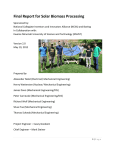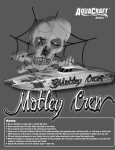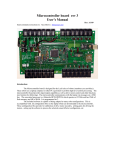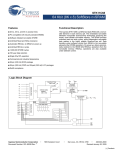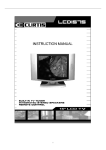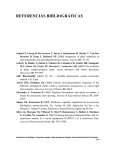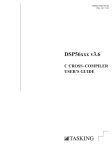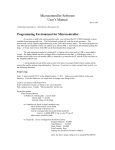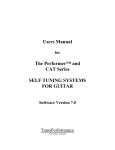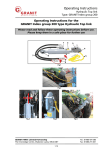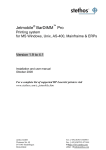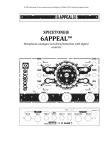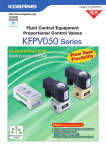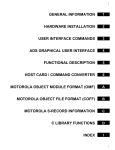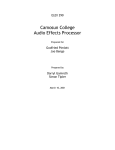Download S.T.A.G. Self-Tuning Acoustic Guitar
Transcript
S.T.A.G. Self-Tuning Acoustic Guitar Team Members: Dustin House Chris Moorman John Mouser Brian Neill Jack Skinner Faculty Advisors: Dr. Juliet Hurtig Dr. John-David Yoder Date: 11/04/05 Executive Summary The goal of our system is to provide musicians of all ages and skill levels with accurate hands-free tuning. The system is unique in that it is designed for an acoustic guitar. The design will implement several major components. To begin, a device will be used to collect the vibrations from a single plucked guitar string, and convert them into an electronic signal. The signal will then be used to record the appropriate frequency of each string. The information containing the fundamental frequency of the plucked string will be sent to a microprocessor, where it will be compared to the desired tuning. A touchpad and LCD screen will be part of the user interface and allow the consumer to choose which note they would like to assign to the string(i.e. E,A,D,G,B). After the configuration is completed, the signal generated in the microprocessor will be sent to control the rotation of a small servo motor. This will alter the tension in the string in order to tune the guitar. In addition, the system will possess an on/off option, which allows the user to switch between manual and automatic tuning. It is expected that a fully functional model will cost the consumer between $150 and $250. The design of our self-tuning acoustic guitar system should be completed in an efficient manner and if time permits, once the initial goals have been met, effort will be made to emphasize the portability of the system and ability to completely tune all six strings simultaneously. In addition, our group, with the assistance of the Ohio Northern University College of Business Administration, will be applying for a grant to help fund the production of this new innovation. -1- Table of Contents Executive Summary ............................................................................................................ 1 Problem Statement .............................................................................................................. 3 Existing Systems................................................................................................................. 4 System Specifications ......................................................................................................... 5 Operational Description ...................................................................................................... 6 Constraint Analysis (Consideration Factors) ...................................................................... 7 Design Deliverables .......................................................................................................... 10 System Design .................................................................................................................. 11 Hardware Research/Decision........................................................................................ 11 Hardware Block Diagram ............................................................................................. 14 Hardware Block Diagram Description.......................................................................... 15 Software Research /Decision ........................................................................................ 15 Software Flow Chart ..................................................................................................... 16 Software Flow Chart Description ................................................................................. 17 User Interface................................................................................................................ 17 Budget ............................................................................................................................... 18 Project Scheduling ............................................................................................................ 19 Conclusion ........................................................................................................................ 20 Appendices........................................................................................................................ 21 Appendix A: References ............................................................................................... 22 Appendix B: Decision Matrices.................................................................................... 23 Appendix C: Completed Gantt Chart............................................................................ 26 Appendix D: Team Members Resumes ........................................................................ 27 -2- Problem Statement In today’s music industry, guitar players are constantly defining their own sound and coming up with various tuning schemes in order to do so. A tuning scheme is an arrangement of notes to which the strings on the guitar are tuned. Often a guitar comes out of tune, or a string may break and need to be replaced and tuned in a time efficient manner. One of the ways to remedy this problem would be the ability to tune the guitar automatically in a multitude of situations. This would prevent the user from wasting time to manually tune a guitar or switch to a guitar with an alternate tuning in the middle of a performance. The ability to change tuning schemes with the touch of a button provides benefits to the average guitar player that up until now have been out of reach. Tuning a guitar has always been a tedious and time-consuming task and it seems that novice guitar players often have trouble in accurately tuning their instrument. Properly tuning a guitar by ear is an art form and it is something that not everyone can master, including those who are expert guitar players. Existing methods of tuning a guitar include using a tuning fork or similar device, or relying on a hand-held electronic tuner. Both of these methods can be inaccurate and still require the user to do all of the work in actually tuning the guitar. The self-tuning guitar systems that exist on the market today are geared more toward the use of an electric guitar, and only offer the ability to customize tuning schemes at the expense of a much pricier system. For these previously stated reasons, our senior design group proposes the idea of a self-tuning acoustic guitar system that would not only be affordable to the average guitar player but would also allow them to be more creative and confident in their guitar playing style. -3- Existing Systems Although the market is saturated with hand-held electronic guitar tuners, there seem to be only a few alternatives when it comes to a fully functioning self-tuning guitar system. The most well-known and marketed of these products is The Performer™ by Transperformance. This self-tuning guitar system is made for use with an electric guitar and implements many of the same principles of tuning the guitar as we will use for our project. Differences include the fact that this system is currently only made for an electric guitar, it can only be retrofitted for certain guitar body styles, it is fully customizable, and it tunes the strings at the bridge of the guitar instead of at the head. Although this system has all the bells and whistles, it is priced between $3500 and $4000, depending on the body style of the guitar in which it must be installed. The price makes this system unaffordable for the average guitar player and especially for those who are novices. There is an acoustic version of this system that is being developed, but again it is very expensive at $14,500, and drastically changes the composition of the guitar. Another product that is on the market right now, the String Master™ Robotic Guitar Tuner, is a hand held automatic tuner that is similar to the small electronic guitar tuners. This system uses a small machine to record the frequency of a string as it is plucked. A fitting attached to a motor must be held over the tuning peg on the head of the guitar as it tightens or loosens the string. It is noted that this system only works for standard tunings, meaning that there are no options for customized tuning schemes. The String Master™ is an affordable system, costing only $100, but at this price, the system compromises accuracy and functionality. In order for the tuner to work properly, you must hold it steady as the motor turns the tuning knob and keep close watch to make sure the motor stops when it is supposed to. Several other groups have attempted to build a self-tuning guitar system but have only focused on the electric guitar. These attempts for the most part have been sub-par and have not incorporated all of the features that are desired by the consumer. For these reasons we feel that this leaves the market open for a product such as ours. -4- System Specifications When defining the specifications of a guitar tuning device such as this, it is important to note the accuracy of the system. The specifications for the self-tuning acoustic guitar will be established under the assumption that the guitar itself is capable of meeting the specifications. Looking at the distinguishable differences in sound between the various notes on a guitar, the change from a whole note to a flat or a sharp is referred to as a half step or a semitone. A semitone is one twelfth of an octave and is made up of 100 smaller units known as cents. Another unit is the centitone, which is equivalent to two cents, or 1/600th of an octave. Because the human ear is sensitive to changes in frequencies between 1 kHz and 8 kHz, and changes in frequency ratios between 1.002 and 1.003, the design must accommodate these characteristics. As a ratio, a centitone is equivalent to 1.00116 or 2(1/.600), and represents half of the ratio of a perceptible change in frequencies. Because of this, the self-tuning acoustic guitar should have an accuracy of ≤ ±2 centitones, or ≤a±4.cents. To obtain this accuracy, the motor will be required to turn the tuning peg within an estimated 1 to 2 degrees of the desired note. The accuracy will depend on both the frequency detection by the pickup, and error due to the control system. Another parameter of the system that must be addressed is tuning time. It is assumed that this product will be used during a live performance. With this in mind, the user must be able to change tunings between songs in a relatively small amount of time. Assuming that each string would be tuned individually and the user would have to pluck each string at least twice, it has been determined that the tuning process for the entire guitar should take no longer than 30 seconds, or 5 seconds per string. If simultaneous tuning were available this process would take less than 10 seconds. When considering the speed at which the guitar is tuned, it is important to note that the motors should not be turning at an unsafe speed that would cause the string to break. It is common knowledge among guitarists that when tuning a string, if the user is tuning the string down to a lower frequency (note), he/she should tune down past the desired note and then tune back up to that note. This technique prevents increased tension between the neck and the bridge. The self-tuning acoustic guitar system should implement the same type of tuning pattern to ensure that the string is tuned accurately and will not immediately come out of tune. This tuning pattern will be implemented within the code written for the microprocessor and for the control system. In addition, the LCD screen will be programmed in a way that will provide a userfriendly interface that not only allows for the selection of a certain tuning scheme, but also displays the notes within that particular tuning. -5- Operational Description Figure 1. Operational Block Diagram. The first step of the design will allow the user to choose between manual and automatic tuning. Manual tuning would cause the system to turn off, thus making it possible to tune the system by hand. If automatic tuning was selected, the user will select one of several tuning schemes via a press of the keypad. This choice will then be sent directly to the microcontroller for processing in the near future. The system would then be ready for tuning, which means the user will need to pluck a string to initiate the process. After this occurs, the hexaphonic pickup will capture the sound and send it as input to the digital signal processing (DSP) chip. The hexaphonic pickup is a device that detects and captures mechanical vibrations from the plucked strings and converts them into electronic signals. Through a series of transformations, this input will be manipulated to define a corresponding fundamental frequency. This frequency is sent directly to the microcontroller to be analyzed along with the desired frequency specified earlier. These two frequencies will be compared to determine if the string is flat, sharp or in tune. If the string is not in tune, the microcontroller will determine the relationship between the two frequencies (actual and desired) and set a variable to display the direction the motor will be turning. Through a specialized algorithm, the microcontroller will determine the necessary amount to turn the motor to tighten or loosen the string. This information will then be sent to the motor and its control block and cause the tuning to occur. After this process is completed, the guitar has been successfully tuned and the system can be shut down. -6- Constraint Analysis (Consideration Factors) Economic Regarding economic factors, we must look at the cost of actually building the prototype and the cost of the time it takes to build it. Although the prototype will cost much more to build than the actual product (buying all of the parts individually), we must remember that the product, when mass produced, must be affordable to the consumer. This is important because we are trying to provide a cheaper alternative for a self-tuning guitar. We must also take into account things such as the cost of software licenses. It will need to be determined how many units of the system will be sold in order for the company to break even, and if this number is attainable. Also, the quality of the components of the tuning system should not be sacrificed because of cost. Environmental Our goal is to produce a product that is “environmentally friendly”. In order to do this several aspects of the self tuning system will have to be closely examined. First, with the increasing amounts of non-recyclable parts of computers and electronics, it is important that we strive to build our prototype with parts that can easily be broken down and discarded or recycled. This task is definitely attainable in our project seeing that the majority of our system will be composed of plastic or some sort of metal. In addition, our product should not consume an exorbitant amount of energy. Being that the system will be running off a series of batteries, we need to make sure that there is an on/off option for the system and that when the system is being operated it is using the energy from the batteries in an efficient manner. Another consideration is that the product should not give off an excessive amount of heat. This issue is not only a safety factor, but in a way the extra heat may “pollute” the air around the product. This could be potentially dangerous to the product and would cause the system to fail and have to be replaced, creating more waste. Sustainability Concerning a sustainable product we need to make sure that our tuning system will be built so that it will endure for a reasonable amount of time. The parts themselves should be made out of durable materials and each individual part should be able to be easily replaced if needed. The system must be able to be adapted to future changes in guitar manufacturing. It must also contain components that will still be produced for many years to come. The code that is used to program the DSP chip and microcontroller must allow for updates in order to adapt to changes in tuning schemes. Overall, the selftuning system should serve the same purpose in 10-20 years as it does now, without having to modify the system too much or add any additional parts. Manufacturability Our self-tuning guitar system will need to implement a design that has the fewest components possible in order to drive down the chance of failure. We must also consider that in some cases, such as the motor and mechanism design, it may be easier and less time consuming to use more motors, rather than designing an entire mechanism using solenoids and bevel gears to turn the tuning pegs. When we are purchasing microchips -7- and electrical components, we will look to buy parts that are commonly used for cost reasons and ease of repair. The design of the system should be easily fabricated. In our case we will have three main components: the pickup, the user interface, and the mechanical system which will be fixed on the head of the guitar. The user interface will include the microcontroller, DSP components, LCD screen, and touch pad. Indicators will be included to make sure the user knows the system is on and that he/she is using it properly. The bulk of the system will be housed in a plastic box which will only display the LCD screen and touch pad. The self-tuning system will have to be easily attached and detached from the fixed motors and have a clean interface in reading in the signals from the guitar itself. Though the motors and mechanism may have to be professionally installed at the time of guitar production or possibly post-production, the only connection that the user should have to deal with is that of attaching a ribbon cable to connect the two parts of the system. Mechanical parts should all be flush and any cuts or modifications should be cleaned up. In addition, it is our intent, if time permits, to design our own circuit boards to be more efficient and save money in using pre-existing boards. The design of the self-tuning system should be easily reproduced. Ethical The purpose of this project is to develop a product that will benefit society in some way. With this is mind it is of the utmost importance that our product is original and we are not infringing upon others’ ideas and/or designs. Although the market for selftuning guitar systems is relatively small, there do exist a handful of systems on the market. The most advanced of these systems, The Performer™, is the first fully functioning self-tuning guitar system that is being marketed. This system incorporates many of the same ideas that we have for our system, but there are several differences. Our system will implement a different way of tuning the strings of the guitar than The Performer™, although the way in which the information is processed will be similar. Our product will be designed so that it is affordable to the consumer. We must also make sure that we obtain the proper licenses for any of the software. Another ethical consideration is designing the system so that it does not fail constantly, causing the consumer to spend money on new systems or parts. Although few patents actually exist for a self tuning guitar, we will make sure that our design does not copy existing designs. Health and Safety Our design should meet all safety standards and regulations. The mechanisms used to tune each string should be enclosed in a housing to prevent the user from injuring themselves due to the meshing gears. The motors that are chosen should meet safety specifications in that they should not overheat or rotate too quickly for the application. The shaft of the motors should be enclosed just as the mechanism is. A user manual will be produced to ensure the safety of the user. The consumer should know exactly how to properly operate the tuning system and be warned that improper use may result in system failure or injury. As was mentioned earlier, the electrical components of the system should be up to code with any bare wires being covered and all power sources safely installed. Special attention should be paid to the electrical components and the chance -8- that they may overheat. Devices such as heat sinks or small fans may need to be installed to prevent this. Also, the electrical signals should not cause any outside interference. Social The self-tuning guitar system should and will provide a benefit to society and be used to better the music industry. It will revolutionize the way guitar players compose songs and play during live performances. This system should provide benefits to a wide spectrum of guitar players from the most advanced to novices. Immediate effects of the advantages of this system will be seen as soon as the first string is plucked. It will save the consumer time and money in the long run and will be used to expand the creativity of the individual guitar player. The self-tuning system should be designed in a way that will not have adverse affects on society or will not be used for unintended purposes. We must consider the fact that this tuning system will eliminate the need for some items in the music industry but we must make sure that these parts of the industry will still thrive. It is our intention to better the music industry, not to diminish the business of other musicrelated companies. Political We must remember that during this design process we are representing the image of Ohio Northern University and the field of engineering. We would not want to design something that would compromise the reputation of these institutions. In addition it is important that we abide by any governmental regulations. It is or duty to communicate our plans to the appropriate people so that we are all on the same page. It is also our duty to defend our design choices. -9- Design Deliverables Upon completion of this project the College of Engineering at Ohio Northern University will receive a functioning prototype of the self-tuning acoustic guitar system. The prototype will include the main unit which will house the microcontroller, DSP board, LCD screen, and touchpad. The peripheral units, which will be fixed on the guitar, are the servo motor and gears, as well as the hexaphonic pickup that will be installed near the bridge of the guitar. In addition to the previously mentioned components, the system will be presented with all the necessary computer code that will be implemented on the DSP board and on the microcontroller. The prototype will be able to recognize a plucked string, record the frequency of that single string, and then adjust the string to the required frequency by way of the motor. In addition to standard tuning, there will be the option to choose alternate tunings for the individual string. The deliverables are organized by the appropriate category below and include the expected dates of completion, as seen in the completed Gantt chart in Appendix C. Purchasing -Microcontroller -DSP Board -LCD Display -Touchpad -Servo Motors -Electrical Components Mon 11/28/05 - Fri 12/16/05 Mon 11/28/05 - Fri 12/16/05 Mon 11/28/05 - Fri 12/16/05 Mon 11/28/05 - Fri 12/16/05 Mon 11/28/05 - Fri 12/16/05 Mon 11/28/05 - Fri 12/16/05 Computer Coding/Electronics Design -Signal Processor/Microcontroller Interface -Signal Processing Design/Wiring -Serial LCD Display Interface -Microcontroller/Servo Motor Interface -Custom Tuning schemes Mon 12/05/05 - Fri 12/16/05 Mon 12/05/05 - Fri 12/16/05 Mon 12/12/05 - Wed 12/14/05 Wed 01/04/06 - Mon 1/23/06 Tues 01/24/06 - Tues 2/21/06 Mechanism Design -Tuning Knob Control/Gear Design -Servo Motor Placement -Mechanism Fabrication Mon 11/28/05 - Fri 12/16/05 Mon 12/12/05 - Fri 12/16/05 Mon 01/09/06 - Fri 02/03/06 -10- System Design Hardware Research/Decision When determining the arrangement of a self-tuning guitar system, the primary concern is ensuring that the added system has no effect on the functionality of the guitar. This comes from a market based on consumers who are very particular regarding modifications to their guitar. One goal of this project is to design the system such that an experienced guitar player would take little notice to the addition of foreign components. In an effort to achieve this goal, several in-depth decision matrices, seen in Appendix B, were generated comparing size, weight, accuracy, and other parameters affecting both the performance of the system and its overall effect on the instrument. Motor Mounting An important design decision was whether to mount the motor on the head-stock of the guitar to turn the machine head or to place the motor on the inside of the guitar body to pull and hold the strings. A requirement for placing the motor inside the guitar is the extra reinforcement of the guitar due to the force of the motor against the body of the guitar. A mechanism to hold the tension of the strings will also be required for this system. This design has the drawback that it would be considerably more difficult to restring the guitar if the motor system was mounted inside the body. Another complication arises when installing the system inside the guitar in that it will need to be taken apart to accurately place the designed system. When examining the alternative of installing the motor on the head-stock, a downfall would be the extra weight and size added to the top of the guitar. This design may be bulky, but most of the system will be hidden behind the head-stock. The various design considerations for this decision were as follows: the amount of alteration to the guitar, the ease of mounting, the effect on appearance, the required reinforcement, and the ease of restringing. The decision matrix for mounting the motor on the head vs. the body of the guitar can be seen in Table 1 of Appendix B. If the motor is mounted on the head-stock, less structural alteration to the guitar is required. Though placing the motor on the headstock will be less aesthetically pleasing, it will be easier to mount it in this way than inside of the guitar. In addition, the required reinforcement for mounting the motor inside is much greater than mounting it on the head-stock. Installing the motor on the head-stock allows for the traditional method of restringing the guitar while installing it inside does not. Number of Motors The next decision helped distinguished between the use of one individual motor per string versus the option of including solenoids and bevel gears to transfer the mechanical energy of one motor to three strings. Although the main goal of this project is to develop the technology to accurately tune one string, the ultimate goal if time permits is to apply this technology to each string of the guitar. In order to depict the two setups being compared, it is assumed that the decision to place the mechanical system on the head of the guitar has already been made. The first setup, seen in Figure 2, involving the -11- use of bevel gears and solenoids is more complex. Two motors would be placed such that the output shafts run parallel with the neck of the guitar. Bevel gears would then change the axis of rotation to be in line with each individual tuning head (controlling each string). Solenoids would allow for engagement and disengagement of each such that only one string’s tension would be altered at any given time. The simpler of the two possibilities in this decision, one motor per string, would place a motor in an arrangement that allows the output shaft to be parallel with the shaft containing the tuning peg. This configuration can be seen in Figure 3. Between these two shafts, spur gears would be used to transfer rotational motion, allowing for the option of gear reduction. SPUR GEARS BEVEL GEARS SOLENOID SPUR GEARS MOTOR MOTOR Figure 2. Bevel Gears and Solenoid Figure 3. One Motor Per String It wasn’t surprising that the option utilizing a single motor per string won the decision matrix due to the complexity of the solenoid option. The option with solenoids and bevel gears contained more mechanical components, which should always be kept to a minimum. It also required more alteration to the guitar head due to the placement of more mechanical components. Although it was believed that the solenoid and bevel gear option would improve characteristics such as size and weight of mechanical system, the complexity and price of the components outweighed such benefits. More importantly, the use of bevel gears and solenoids strongly hindered the capability to further this project toward tuning all six strings. The complete decision matrix for this part of the hardware can be seen in Table 2 of Appendix B. Servo Motor vs. Stepper Motor Several considerations were examined in selecting which type of motors, servo or stepper, the project should use. These include size, torque, price, and accuracy. The motor is required to fit between the tuning pegs of the guitar. These small motors must produce the correct amount of torque in order to turn the pegs. The torque was calculated as follows. First, a small metal ruler was attached to a tuning peg that was turned close to the maximum tension of the string. Weights were then added 3 inches away from the center -12- of the mechanism, and the weight was incremented until the torque created turned the tuning peg. This weight was estimated to be 350 grams at 3 inches away from center. Using this data, the torque was calculated. The weight in grams was converted to pounds mass 350 grams 0.7716 lbm (Eqn.1) The force was calculated F ma (0.7716 lbm)(32.2 ft / s 2 ) 24.846 lbm ft / s 2 (Eqn.2) 1lbf 0.7716 lbf F 24.846 lbm ft / s 2 * 2 32 . 2 lbm ft / s (Eqn.3) The force in pounds was converted to ounce force 0.7716 lbf * 16 oz / lb 13.2589 oz force (Eqn.4) Finally, the torque was calculated Torque F d (13.2589 ozf )(3inches) 37.0 oz in (Eqn.5) Though it is possible to find both a stepper and servo motor that satisfy the size and torque constraints listed above, it was determined that a servo motor would better suit the price constraint. Small stepper motors must use the more expensive rare earth magnets in order to produce the needed torque, resulting in a cost of over $100 per unit. Servos that met the two constraints, on the other hand, fell within a price range of $15.00 to $20.00 per unit. It was determined that a servo motor would allow for more accurate tuning, because it uses a potentiometer that allows the shaft to stop at any angle, instead of being limited to the step angles of a stepper motor. Most servos that are rated at this torque have built-in mechanical stops, which limit the range of the shaft movement. Because of this, the stops must be removed to allow for continuous clock-wise and counter-clockwise rotation. The decision matrix for this part of the hardware can be seen in Table 3 of Appendix B. Microphone vs. Pickup After the motor selection was made, it was determined whether a microphone or hexaphonic pickup would capture the data for the system. The following four considerations were used in making this decision: simultaneous tuning, effects of background noise, price, and ease of installation. It was determined that a microphone would be limited to tuning one string at a time, whereas the hexaphonic pickup will allow for the frequency of each individual string to be acquired by the system simultaneously. In terms of noise, the microphone would be more affected than the hexaphonic pickup. This is because the microphone captures the sounds of the surrounding environment, whereas the pickup only senses the vibration of the string. The microphone has a smaller -13- price tag than the hexaphonic pickup, but this constraint was not weighted as heavy as the others. Lastly, the installation process of both devices was examined. It was concluded that both devices had nearly the same degree of difficulty when it came to the installation process. The microphone could be inserted into the enclosure of the system, near the touchpad, or just inside of the sound hole of the guitar. This would require the user to hold the guitar within two feet of the system, which may cause a problem during live performances. The hexaphonic pickup, on the other hand, may be easily mounted at the bridge of the guitar, and is limited to be within the length of the cable away from the system. It was determined, as seen in Table 4 of Appendix B, that the hexaphonic pickup was the best choice. Hardware Block Diagram Figure 4. Hardware Block Diagram -14- Hardware Block Diagram Description The user will first press a key on the keypad, creating a desired input to the system. This input will then be sent to the LCD to display the selection and also to the microcontroller to store the desired frequencies for future comparisons. The desired frequency will be the input to a comparator. This comparator will receive the actual frequency as recorded by the DSP chip and send the difference between the frequencies to the microcontroller. The microcontroller will follow preset logic to determine actions of the motor. It will output a value in degrees for the motor to turn (or not turn, if in tune) and compare it to the current position of the motor. This will be sent back to the microcontroller, which will manage the operation of the motor. The microcontroller will send this signal to an amplifier, which in turn will send the amplified signal to the motor. The motor will then send a signal (new position) back to the comparator. The outside feedback loop will contain the pickup for continuous monitoring of the actual frequency of the plucked string. The pickup will output a signal to the DSP chip, which, through a series of Discrete Fourier Transforms (DFTs), will compute the frequency associated with the string. Finally, this signal will return back to the comparator to see if any additional tuning needs to occur. Software Research /Decision After the main components of the programmable hardware were determined, it was then necessary to research the possibilities for software choices. First, was an analysis of the options available for the Motorola MC68HC12. This microcontroller can either be programmed using the standard Motorola assembly language, or with a higher level programming language, such as C or C#. The first option, assembly language, offers direct control over the microcontroller and attached hardware. A disadvantage of this option would be the nature of a low level programming language in that it is very difficult to write and debug without detailed knowledge of the code and system. Due to the familiarity and availability, Motorola assembly language is a viable option. The other option, a high level programming language, poses several unnecessary problems and road blocks. A high level language allows for usage on various systems, unlike assembly language, which is based on the physical hardware. The high level language would cause interfacing and licensing concerns that simply complicate the process of programming the microcontroller. With a high level language, detailed loops and blocks are much easier to write and manage. Similar to a written language, high level languages are easy to debug and follow through the code. It can be assumed that the same options are available for the Motorola DSP56000 and therefore all decisions made for one will affect both components. As shown in Table 5 of Appendix B, the Motorola Assembly language was chosen over a high level programming language. The most important factors were control and familiarity, in which Motorola assembly language ranks higher than a high level language. This made the decision simple as to which programming language would be used for the final product. Overall, both components (DSP56000 and MC68HC12) will -15- be using the Motorola assembly language in order to keep coding consistent throughout the system. Software Flow Chart Figure 5. Software Flow Chart -16- Software Flow Chart Description The first step to the programming aspect of the system will be to receive the input from the keypad. Using a set of masks and bit-checking, the appropriate key will be determined and its corresponding desired frequency will be stored into memory. If some outside flaw occurs and no key can be determined, an error will be outputted to the LCD screen asking the user to reenter the selection. After the frequency has been set, the corresponding note will be displayed on the LCD screen in order to verify the user’s selection. At this point, the DSP chip will have calculated the frequency of the currently plucked string and have it ready to input to the microcontroller. The microcontroller will analyze the actual frequency and compare it to the desired frequency with 4 possible outcomes. First, if the actual frequency is higher than the desired frequency then the motor will be set to turn 2 degrees clockwise in order to loosen the string. Second, if the actual frequency is lower than the desired frequency, the motor will be set to turn 2 degrees counter-clockwise to tighten the string. The next outcome occurs if the actual frequency is equal to the desired frequency. This situation happens only if the string is in tune and therefore the motor will be disabled and a ‘successful tuning’ message will be outputted to the LCD. If none of these 3 outcomes take place, then an error message will be displayed on the LCD. Finally, the system will return back to the monitoring state, waiting for the user to supply input to the keypad. User Interface The system will be activated by pushing the power button, which is located on the 16 button keypad. A message will then appear on the LCD screen asking the user what tuning scheme he/she desires. Several of the other buttons on the keypad will be used to scroll through the preprogrammed tuning schemes, which will be listed on the display. Once the desired tuning is located, an enter button will finalize the selection. If the wrong selection is made, a back key will be present to cancel the setting. The system will then require the user to strum the guitar. The user will continue to strum the guitar until a ‘successful tuning’ message appears on the LCD screen, indicating that the string is in tune. The tuning selection may be changed at any point after the previous selection has been completed. This can be done by entering or scrolling to the new desired tuning and following the same process listed above. -17- Budget The company is to pay for the cost of the prototype and labor, which amounts to $27,213.76. The breakdown of the budget can be seen in Tables 1 and 2. Table 1. Component Budget Part Description Part No. # Price / Unit Total Hexaphonic Pickup Machine Heads Ribbon Cable Strings Servo Motor Keypad LCD Microcontroller DSP Board Gears Miscellaneous Parts G-Vox Pickup Chrome 3+3 N/A Martin pack of 6 strings Futaba S3004 16 Button Indoor Keypad (2x8) OPTREX (20x2 parallel) Motorola Motorola MSP3100 1 1 1 3 1 1 1 1 1 2 $50.00 $16.95 $5.00 $4.99 $20.00 $16.95 $19.89 $100.00 $100.00 $10.00 $50.00 $16.95 $5.00 $14.97 $20.00 $16.95 $19.89 $100.00 $100.00 $20.00 $100.00 $100.00 Total $463.76 FUTM0043 07-30009-000 DMC2026IANB-2Y-20 M68HC12 DSP5600x Miscellaneous Table 2. Time Budget Academic hours in Capstone 9 *Weeks per quarter 11 Class hours in Capstone 99 *Hours per academic hour outside of class 2 198 Hours outside of class *Number of team members 5 Total out of class man hours 990 *Cost of hourly engineering time $25.00 Total cost of Engineering Time $24,750 Number of marketing students 2 *Hours spent on project 40 Total time spent on project 80 *Cost of hourly marketing time $25.00 Total cost of Marketing Time $2,000 Total cost of Labor $26,750 -18- Project Scheduling The timeline and process for this design project has been divided into three main phases. Preliminary design work is the first phase. A majority of this phase consisted of researching existing systems and determining what hardware would be used for our design. During this research, careful planning was directed toward identifying the market for such a product and ensuring that the consumers’ needs are fulfilled. This portion of the design process was very dynamic. The hardware and the final goal of the project were constantly changing together as the design group gained a better understanding of what the project would consist of and how it would be completed. The second phase of this design project is the design and construction of the prototype. At the beginning of this phase, all emphasis will be placed on finalizing hardware specifications and generating purchase orders. Once these orders have been placed, there will be a two week break, thus allowing time for shipping. Upon arriving back from break, the hardware will be modified and assembled. While the components are awaiting arrival, the code will be developed for the microprocessor and digital signal processor. Mechanically, the motor will be mounted and gears arranged for the desired transfer of energy. The third and final phase of the design project will place emphasis on troubleshooting, perfecting, and customizing the final product. Time permitting, the design group will take the prototype from this proposal and further the developed technology to allow for the tuning of additional strings. The completed Gantt chart for this project is located in Appendix C. Midway through the first quarter, two students from the Ohio Northern University College of Business Administration were added to the design group. They are bringing a perspective to the group that will aid in our market analysis. This network between both colleges will also assist in the development of the National Collegiate Inventors and Innovators Alliance (NCIIA) grant proposal. Within this proposal, NCIIA expects a market analysis identifying significant economic factors for each group’s design. Weekly meetings are being held with these students to meet the proposal’s December 2nd deadline. After the proposal is completed, the students from the College of Business Administration are expected to further their market analysis to help identify the future of our self-tuning acoustic guitar. -19- Conclusion This proposal for a self-tuning acoustic guitar system represents the development of a product that has a promising future within the music industry. We have researched several existing products and have developed the design of a functional prototype. Our plan of implementation includes the previously specified hardware and software applications as well as a project timeline to ensure that the product is delivered in a timely manner. Our self-tuning guitar system will combine three major components to allow for the automatic tuning of a guitar string to a specified note, all with the simple pluck of the string. We believe that our product will fulfill the needs of the consumer, and will benefit both novice and expert guitar players. -20- Appendices Appendix A: References Appendix B: Decision Matrices Appendix C: Completed Gantt Chart Appendix D: Team Members Resumes -21- Appendix A: References 1. Action Tuners. 3 Nov. 2005 <http://www.actiontuners.com>. 2. 3. Digikey Corporation. 1 Nov. 2005 <http://www.digikey.com.> El-Sharkawy, Mohamed. Real Time Digital Signal Processing Applications With Motorola’s DSP56000 Family. Englewood Cliffs, NJ. Prentice-Hall, Inc., 1990. 4. “Intro to RC Servos.” The Wolfstone Group. 27 Oct. 2005 <http://wolfstone.halloweenhost.com/TechBase/svoint_RCServos.html>. 5. Jameco Electronics. 3 Nov 2005 <http://www.Jameco.com>. 6. Lachish, Ilan. “Automatic Guitar Tuner.” Thesis. University of Queensland, 2001. 7. “Modifying the HS-300 Servo.” Acroname Easier Robotics. 27 Oct. 2005 <http://www.acroname.com/robotics/info/ideas/continuous/continuous.html>. 8. National Collegiate Inventors and Innovators Alliance. 3 Nov. 2005 <http://nciia.org>. 9. Orfanidis, Sophocles J. Introduction to Signal Processing. Upper Saddle River, NJ. Prentice-Hall, Inc., 1996. 10. Salt, J. Eric, and Robert Rothery. Design for Electrical and Computer Engineers. Danvers, MA. John Wiley & Sons, Inc. 2002. 11. Stock Drive Products / Sterling Instrument. 1 Nov. 2005 <http://www.sdpsi.com>. 12. TransPerformance. 3 Nov. 2005 <http://transperformance.com>. 13. WorldServo. 28 Oct. 2005 <http://www.worldservo.com>. -22- Appendix B: Decision Matrices Table 1. Mounting Location Decision Matrix ALTERATION TO GUITAR EASE OF MOUNTING EFFECT ON APPEARANCE REQUIRED REINFORCEMENT EASE OF RESTRINGING 4 (LOW) 4 (HIGH) 5 (LOW) 5 (LOW) 3 (HIGH) SCORING WEIGHT HEAD BODY 2 4 2 1 5 (2.4) (3.2) (4.0) (5.0) (3.0) 4 1 5 5 3 (1.6) (0.8) (1.0) (1.0) (1.8) TOTAL 17.6 6.2 * All ratings were on a scale of 0-5 based on importance. The scores are listed in parenthesis below each rating. Table 2. Mechanical System Decision Matrix SCORING WEIGHT 3 (LOW) 3 (HIGH) 3 (LOW) 5 (HIGH) 4 (LOW) 4 (LOW) 4 (LOW) 5 (HIGH) SOLENOIDS AND BEVEL GEARS 32 4 3 2 3 2 2 0 (1.7) (2.4) (2.0) (2.0) (1.6) (4.0) (4.0) (0) 1 MOTOR PER STRING 18 5 2 4 2 4 4 5 (3.0) (3.0) (3.0) (4.0) (2.4) (2.0) (2.0) (5.0) * All ratings were on a scale of 0-5, based on importance, aside from the actual number of components. The scores are listed in parenthesis below each rating. -23- 17.7 24.4 Appendix B: Decision Matrices Table 3. Motor Type Decision Matrix PRICE SIZE ACCURACY 4 (LOW) 5 (LOW) 4 (HIGH) SCORING WEIGHT SERVO STEPPER 2 2 (2.4) (3.0) TOTAL 4 8.6 (3.2) 4 4 3 (0.8) (1.0) (2.4) 4.2 * All ratings were on a scale of 0-5 based on importance. The scores are listed in parenthesis below each rating. Table 4. Acoustic-Electro Conversion Decision Matrix SCORING WEIGHT HEXAPHONIC PICKUP MICROPHONE SIMULTANEOUS TUNING EXTERNAL NOISE PRICE EASE OF INSTALLATINO 5 (HIGH) 5 (LOW) 4 (LOW) 3 (HIGH) 5 1 4 3 (5.0) (5.0) (1.6) (1.8) 0 4 2 2 (0.0) (2.0) (3.2) (1.2) * All ratings were on a scale of 0-5 based on importance. The scores are listed in parenthesis below each rating. -24- TOTAL 13.4 6.0 Appendix B: Decision Matrices Table 5. Programming Language Decision Matrix SCORING WEIGHT CONTROL CODE SIMPLICITY DEBUGGING FAMILIARITY AVAILABILITY 5 (HIGH) 5 (HIGH) 4 (HIGH) 4 (HIGH) 3 (HIGH) MOTOROLA ASSEMBLY 5 2 2 5 5 (5.0) (2.0) (1.6) (4.0) (3.0) HIGH LEVEL LANGUAGE 3 4 4 4 3 (3.0) (4.0) (3.2) (3.2) (1.8) * All ratings were on a scale of 0-5 based on importance. The scores are listed in parenthesis below each rating. -25- TOTAL 15.6 15.2 Appendix C: Completed Gantt Chart -26- Appendix D: Team Members Resumes




























